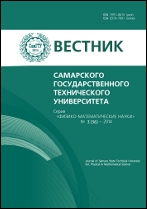|
This article is cited in 6 scientific papers (total in 6 papers)
Differential Equations and Mathematical Physics
Lévy d'Alambertians and their application in the quantum theory
B. O. Volkov
Bauman Moscow State Technical University, Moscow, 105005, Russian Federation
(published under the terms of the Creative Commons Attribution 4.0 International License)
Abstract:
The Lévy d'Alambertian is the natural analogue of the well-known Lévy-Laplacian. The aim of the paper is the following. We study the relationship between different definitions of the Lévy d'Alambertian and the relationship between the Lévy d'Alambertian and the QCD equations (the Yang–Mills–Dirac equations). There are two different definitions of the classical Lévy d'Alambertian. One can define the Lévy d'Alambertian as an integral functional given by the second derivative or define it using the Cesaro means of the directional derivatives along the elements of some orthonormal basis. Using the weakly uniformly dense bases we prove the equivalence of these two definitions. We introduce the family of the nonclassical Lévy d'Alambertians using the family of the nonclassical Lévy Laplacians as a model. Any element of this family is associated with the linear operator on the linear span of the orthonormal basis. The classical Lévy d'Alambertian is an element of this family associated with the identity operator. We can describe the connection between the Lévy d'Alambertians and the gauge fields using the classical Lévy d'Alambertian or another nonclassical Lévy d'Alambertian specified in this paper. We study the relationship between this nonclassical Lévy d'Alambertian and the Yang–Mills equations with a source and obtain the system of infinite dimensional differential equations which is equivalent to the QCD equations.
Keywords:
Lévy Laplacian, Lévy d'Alambertian, Yang–Mills equations, Yang–Mills–Dirac equations.
Original article submitted 16/XII/2014
revision submitted – 13/III/2015
Citation:
B. O. Volkov, “Lévy d'Alambertians and their application in the quantum theory”, Vestn. Samar. Gos. Tekhn. Univ., Ser. Fiz.-Mat. Nauki [J. Samara State Tech. Univ., Ser. Phys. Math. Sci.], 19:2 (2015), 241–258
Linking options:
https://www.mathnet.ru/eng/vsgtu1372 https://www.mathnet.ru/eng/vsgtu/v219/i2/p241
|

| Statistics & downloads: |
| Abstract page: | 882 | | Full-text PDF : | 296 | | References: | 113 | | First page: | 19 |
|




 Contact us:
Contact us: Terms of Use
Terms of Use
 Registration to the website
Registration to the website Logotypes
Logotypes










 Citation in format
Citation in format 
